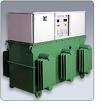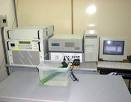Sources of disturbances in electrical networks
Harmonicas
Higher harmonics (multiples) are sinusoidal voltages or currents whose frequency differs from the fundamental frequency by a whole number of times.
Harmonic distortions of voltages and currents occur due to the presence of elements or equipment in networks with a non-linear current-voltage characteristic. The main sources of harmonic interference are converters and rectifiers, induction and arc furnaces, fluorescent lamps. Televisions are the most frequent sources of harmonic interference in household equipment. A certain level of harmonic disturbances can also be created by the equipment of the power system: rotating machines, transformers. As a rule, however, these sources are not the main ones.
The main sources of multiple harmonics are: static frequency converters, cycloconverters, asynchronous motors, welding machines, arc furnaces, superimposed frequency current control systems.
Static frequency converters consist of an AC-to-DC rectifier and a DC-to-AC converter with the required frequency.The DC voltage is modulated by the output frequency of the converter, resulting in multiple harmonics appearing in the input current.
 Static frequency converters are mainly used for variable speed motors, the application of which is rapidly developing. Engines with a capacity of up to several tens of kilowatts are connected directly to low-voltage networks, more powerful ones to medium-voltage networks through their own transformers. There are several implementation schemes static frequency converters with different characteristics. The frequencies of the multiple harmonics depend on the output frequency and the pulse frequency of the converter. Similar converters are also used for furnaces operating at medium frequencies.
Static frequency converters are mainly used for variable speed motors, the application of which is rapidly developing. Engines with a capacity of up to several tens of kilowatts are connected directly to low-voltage networks, more powerful ones to medium-voltage networks through their own transformers. There are several implementation schemes static frequency converters with different characteristics. The frequencies of the multiple harmonics depend on the output frequency and the pulse frequency of the converter. Similar converters are also used for furnaces operating at medium frequencies.
Cycloconverters are high-power (several megawatts) three-phase converters that convert three-phase current from the original frequency to three-phase or single-phase current at a reduced frequency (typically less than 15 Hz), used to power low-speed, high-power motors. They consist of two controllable rectifiers that conduct current alternately in one direction or the other. Cycloconverters are used in very rare cases. Interharmonic currents reach 8-10% of the fundamental frequency current. Due to the high power of cycloconverters, they are connected to networks with high short-circuit power, so that interharmonic voltages are low. Measurements carried out in two such installations in Switzerland showed that their values in networks of 50 and 220 kV did not exceed 0.1% of the nominal voltage.
Induction motors can in some cases generate interharmonics due to the gap between the stator and the rotor, especially when combined with steel saturation. At normal rotor speed, the interharmonic frequencies are in the range 500-2000 Hz, but when the engine is started, they "pass" through the entire frequency range to the steady state value. Interference from motors can be significant when installed at the end of a long low voltage line (more than 1 km). Interharmonics of up to 1% were measured in these cases.
Welding machines and electric arc furnaces generate a wide and continuous spectrum of harmonics. frequencies of harmonics and interharmonics generated by the converter equipment.
Voltage deviation
 Voltage deviations are caused by changes in consumer load during the day and the corresponding operation of voltage regulating devices (transformers with load switches).
Voltage deviations are caused by changes in consumer load during the day and the corresponding operation of voltage regulating devices (transformers with load switches).
Voltage fluctuations
Voltage fluctuations are a series of random or random changes. cyclical.
Voltage fluctuations are caused by the operation of electrical receivers with a sharply variable nature of energy consumption and occur during the operation of the following equipment: welding and arc welding machines, rolling mills, powerful motors with variable load, electric arc furnaces for the production of steel. Sudden changes in voltage can also occur when switching loads and electrical equipment (eg: capacitor banks).
Short-term voltage drops
 Short-term voltage dips are unexpected voltage drops with its recovery after a time interval of several fundamental frequency periods to several electrical degrees.
Short-term voltage dips are unexpected voltage drops with its recovery after a time interval of several fundamental frequency periods to several electrical degrees.
Short-term voltage drops are caused by switching processes in power systems associated with short circuits, as well as by starting powerful motors. A certain number of such failures caused by the operation of the automation of power systems to eliminate short circuits cannot be removed, and users should take this fact into account.
Voltage pulses
Sources of voltage pulses are switching operations in networks, power systems and thunderstorms.
Unbalance of a three-phase voltage system
The asymmetry of a three-phase voltage system occurs if the phase or phase voltages are not equal in amplitude or the displacement angle between them is not equal to 120 el. hail.
The asymmetry of the three-phase voltage system can be caused by three reasons: the asymmetry of the parameters of the overhead lines due to the lack of transposition of wires or the use of extended transposition cycles. This factor manifests itself mainly on high voltage lines; inequality of phase loads due to their uneven distribution between phases (system asymmetry) or non-simultaneity of their operation (probability asymmetry); — non-phase modes of power lines (after interruption of one of the phases due to damage).
 The degree of voltage imbalance caused by the asymmetry of the power line parameters is usually small (up to 1%).The most significant asymmetry occurs when power lines operate in incomplete phase modes, but such modes are very rare. Therefore, the main most common cause of imbalance is network load.
The degree of voltage imbalance caused by the asymmetry of the power line parameters is usually small (up to 1%).The most significant asymmetry occurs when power lines operate in incomplete phase modes, but such modes are very rare. Therefore, the main most common cause of imbalance is network load.
In industrial networks, sources of asymmetry can be: powerful single-phase loads, induction melting and heating furnaces, welding units, electroslag melting furnaces; three-phase electric receivers operating in asymmetric mode for a long time, electric arc steel furnaces.
Frequency deviation
Frequency deviations occur due to a mismatch between the power of generators generating electricity and the consumed load. When the generator power exceeds the load power, the generators speed increases and the frequency increases proportionally. The power consumed by the load also increases; at a certain frequency value, a balance occurs between generated and consumed power. A similar pattern of frequency reduction is observed if the load power exceeds the generators power.
